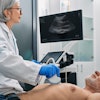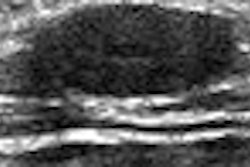ATLANTIC CITY - Ultrasound contrast media is useful in many radiological applications and helps clinical practice, according to Dr. Yuko Kono of the University of California, San Diego (UCSD). She spoke Thursday during a session at this week's 2007 Leading Edge in Diagnostic Ultrasound conference.
"We need ultrasound contrast media approval for radiological applications in the USA," Kono said.
While ultrasound contrast media are cleared only for cardiac imaging applications in the U.S., they are also approved for radiological imaging worldwide. UCSD, however, has utilized ultrasound contrast media off-label in its radiology practice for the care of patients, Kono said.
To report on the impact of contrast-enhanced ultrasound (CEUS) on patient workup and management, UCSD researchers studied 118 patients between April 2000 and September 2006. The patients received either Optison (16 patients), Definity (45), or Imagent (57) contrast agents and scanning using an Elegra or Antares ultrasound scanner (Siemens Medical Solutions, Malvern, PA).
The typical dosage was 0.2 mL for Definity or 1 mL for Optison and Imagent per injection. Images were acquired using contrast-specific imaging software in grayscale using low mechanical index (MI) real-time and intermittent techniques.
The studies were performed to confirm or characterize liver lesions in 70 of the 118 patients (59%), assess vascular patency in 23 of the patients (19%), or evaluate a kidney problem in 14 patients (11%). The eight other patients included two spleen cases, two abdominal wall cases, one pancreatic case, one abdominal lesion, one trauma case, and one acute rejection case.
No adverse reactions were observed. CEUS had no effect in 26 patients (22%), increased confidence in 43 cases (36%), changed diagnosis in some degree but did not affect management in 19 cases (16%), and could have changed management in seven cases (6%). It changed or made the diagnosis and eliminated another test in 11 cases (9%), and changed management in 10 cases (9%).
While the number of patients is small and they were highly selected, ultrasound contrast added critically valuable information in the majority of patients without added risk and at the bedside, Kono said.
"Ultrasound contrast changed patient management in 18% of the cases," she said.
Small indeterminate lesions
In another study designed to assess the accuracy and role of CEUS in diagnosing indeterminate small lesions, UCSD researchers studied 55 patients with indeterminate, early enhancing lesions smaller than 3 cm in diameter detected by contrast-enhanced CT and/or contrast-enhanced MRI.
Of the 55 patients, 24 received triple-phase CT prior to CEUS, while 26 received dynamic MRI studies. Fifteen patients received both CT and MRI, Kono said.
CEUS was performed for lesion characterization, examining tumor vessels and evaluating the pattern and degree of enhancement of arterial, portal, and equilibrium phases on real-time low MI, intermittent, and long-delay imaging, Kono said.
Final diagnosis was available in 35 patients, 23 of whom had cirrhosis and 12 of whom had no liver disease. One lesion was evaluated per patient.
Of the 23 cirrhotic patients, 14 had benign lesions, while nine had malignant lesions. Of the 12 with no liver disease, 11 had benign lesions and one had a malignant lesion.
Noncontrast ultrasound yielded positive findings in 18 true lesions and one pseudolesion, and negative findings in five true lesions and 11 pseudolesions. Overall, the modality had 78% sensitivity and 92% specificity for true lesion detection.
CEUS, however, was positive in 21 true lesions and no pseudolesions, and negative in two true lesions and all 12 pseudolesions for a 91% sensitivity and 100% specificity for true lesion detection. For diagnosing cancer, CEUS led to a malignant diagnosis in 10 malignant cases and two benign cases, and a benign finding in zero malignant cases and 23 benign cases. Overall, CEUS had 100% sensitivity and 92% specificity for the diagnosis of malignancy, Kono said.
"Contrast-enhanced ultrasound is helpful in diagnosing indeterminate small hepatic lesions in both cirrhotic patients and patients without liver disease," she said.
By Erik L. Ridley
AuntMinnie.com staff writer
May 4, 2007
Related Reading
DTHI boosts US performance in hepatic imaging, March 16, 2007
CEUS stars in differentiating PVT in cirrhotic patients, December 7, 2006
CEUS shines in characterizing hypoechoic focal lesions in fatty livers, November 28, 2006
CEUS aids differentiation of small liver lesions, April 3, 2006
Detection of liver metastases with contrast-enhanced ultrasound, March 23, 2006
Copyright © 2007 AuntMinnie.com




















